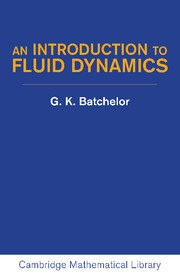Book contents
- Frontmatter
- Contents
- Preface
- Conventions and Notation
- Chapter 1 The Physical Properties of Fluids
- Chapter 2 Kinematics of the Flow Field
- Chapter 3 Equations Governing the Motion of a Fluid
- Chapter 4 Flow of a Uniform Incompressible Viscous Fluid
- Chapter 5 Flow at Large Reynolds Number: Effects of Viscosity
- Chapter 6 Irrotational Flow Theory and its Applications
- Chapter 7 Flow of Effectively Inviscid Fluid with Vorticity
- Appendices
- Publications referred to in the text
- Subject Index
- Plate section
Chapter 6 - Irrotational Flow Theory and its Applications
Published online by Cambridge University Press: 05 June 2012
- Frontmatter
- Contents
- Preface
- Conventions and Notation
- Chapter 1 The Physical Properties of Fluids
- Chapter 2 Kinematics of the Flow Field
- Chapter 3 Equations Governing the Motion of a Fluid
- Chapter 4 Flow of a Uniform Incompressible Viscous Fluid
- Chapter 5 Flow at Large Reynolds Number: Effects of Viscosity
- Chapter 6 Irrotational Flow Theory and its Applications
- Chapter 7 Flow of Effectively Inviscid Fluid with Vorticity
- Appendices
- Publications referred to in the text
- Subject Index
- Plate section
Summary
The role of the theory of flow of an inviscid fluid
We have completed a study of the general effects of the viscosity of the fluid, and are now in a position to take advantage of the fact that the viscosities of the common fluids air and water are quite small. The Reynolds number ρLU/µ (in the notation of §4.7) is usually a measure of the ratio of the representative magnitude of inertia forces to that of viscous forces; and, when this Reynolds number is large compared with unity, viscous forces frequently play a negligible part in the equation of motion over nearly all the flow field. In many cases in which separation of the boundary layer from a rigid boundary does not occur, the flow field tends to the form appropriate to an inviscid fluid, as ρLU/µ → ∞, over the whole of the region occupied by the fluid, and the fact that viscous forces remain significant in certain thin layers in the fluids however large the Reynolds number may be, is of little consequence for many purposes. However, in cases in which the boundary layer does separate from a rigid boundary, the limit is a singular one and, although the region of fluid in which viscous forces are significant may decrease in size to zero as ρLU/µ ∞, the limiting form of the flow field is not the same as that appropriate to a completely inviscid fluid.
Information
- Type
- Chapter
- Information
- An Introduction to Fluid Dynamics , pp. 378 - 506Publisher: Cambridge University PressPrint publication year: 2000
